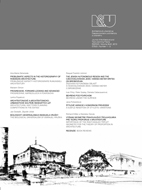THE JEWISH AUTONOMOUS REGION AND THE CZECHOSLOVAKIAN JEWS: HANNES MEYER WRITES ON BIROBIDZHAN
THE JEWISH AUTONOMOUS REGION AND THE CZECHOSLOVAKIAN JEWS: HANNES MEYER WRITES ON BIROBIDZHAN
Author(s): Raquel Franklin UnkindSubject(s): Cultural Essay, Political Essay, Societal Essay
Published by: Historický ústav SAV, v. v. i.
Keywords: Hannes Meyer; Birobidzhan; Soviet Union; resettlement of Jews; Urban Planning; Paul Merker
Summary/Abstract: With the partitions of Poland by the end of the 18th century, the Russian Empire acquired a large number of Jewish subjects territorially confined to the limits of the Pale of Settlement, an area comprising mainly the former Polish-Lithuanian Commonwealth. From that time on, both the Tsarist and Soviet regimes looked for solutions to the “Jewish question”. Tsar Alexander I (1777 – 1825) suggested for the first time in 1804 to settle Jews on the land, an idea the Soviet government would reenact years ahead as part of their program of collectivization of agriculture. By this means, the “futility” of the Jewish bourgeoisie could be transformed into a “productive, meaningful life” and their situation as an abnormal nationality could be solved. The first Soviet attempts to transform Jews into peasants during the early 1920s encountered mixed reactions. On the one hand, both the state and Jewish philanthropic organizations supported the dea of relocation, especially in the Crimea, while on the other, local peasants resented the project as intrusive and dangerous to their own interests. Mikhail Kalinin eagerly promoted the creation of Jewish agricultural colonies, which he believed were the only means to maintain the Jewish nationality. In his words: “The Jewish people faces the great task of preserving its own nationality, and to this end a large part of the Jewish population must be transformed into an economically stable, agriculturally compact group which should number at least in the hundreds of thousands. Only under such conditions can the Jewish masses hope for the future existence of their nationality.” In order to facilitate the creation of such colonies, in1924 the Communist Party established the KOMZET (Committee for the Settlement of Labouring Jews on the Land), a government commission in charge of land distribution among Jews, and its civil counterpart, the OZET (Society for Settling Labouring Jews on the Land) aimed at assisting the colonists in the logistics of settlement, including housing, training, education, provision of tools and cattle, etc. The initiative never achieved its goals; most of the Jews returned to their previous way of life in the shtetls, while others embraced Zionism instead. However, the Crimean experience opened the door to future proposals of the kind, mainly that of Birobidzhan. In 1928 Josef Stalin himself apparently suggested the creation of an urban settlement for Jewish colonization in the Far East /2/ as a response to different concerns ranging from the situation of the Jewish masses to the national scale. First of all, lying on the border with China and extremely under populated, the region was vulnerable to Chinese and Japanese attacks, therefore, security could be enhanced by transferring people to the area. Secondly, unwanted Jews from the European republics such as Belarus and Ukraine could be relocated far away in order to provide them with the necessary condition of a territory to acquire full...
Journal: Architektúra & Urbanizmus
- Issue Year: 47/2013
- Issue No: 1-2
- Page Range: 72-83
- Page Count: 12
- Language: English

